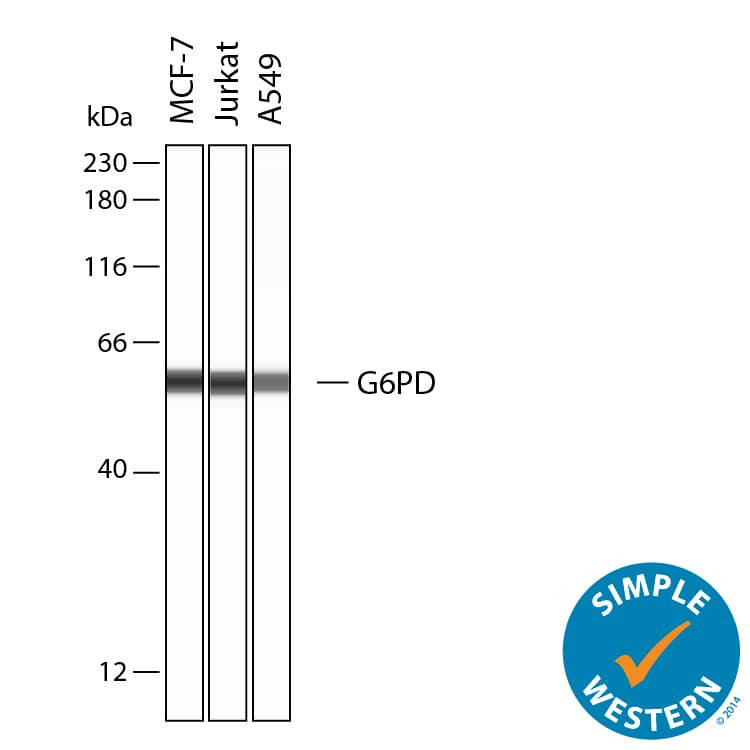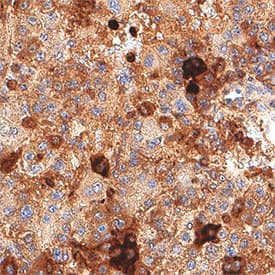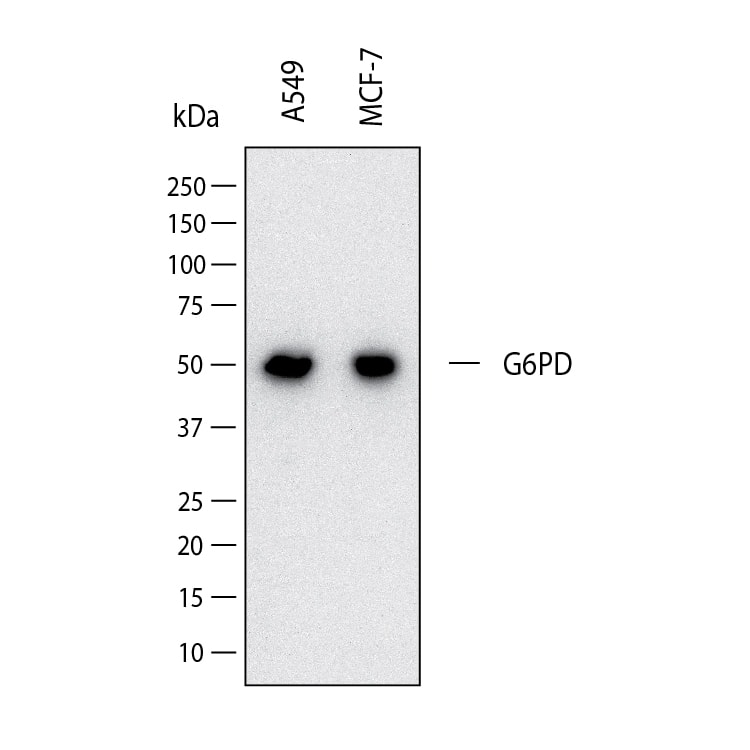Human G6PD Antibody
R&D Systems, part of Bio-Techne | Catalog # MAB11467

Key Product Details
Species Reactivity
Human
Applications
Immunohistochemistry, Simple Western, Western Blot
Label
Unconjugated
Antibody Source
Monoclonal Mouse IgG2A Clone # 1067503
Product Specifications
Immunogen
E. coli-derived human G6PD
Ala2-Leu515
Accession # P11413
Ala2-Leu515
Accession # P11413
Specificity
Detects human G6PD in direct ELISA.
Clonality
Monoclonal
Host
Mouse
Isotype
IgG2A
Scientific Data Images for Human G6PD Antibody
Detection of Human G6PD by Western Blot.
Western Blot shows lysates of A549 human lung carcinoma cell line and MCF-7 human breast cancer cell line. PVDF membrane was probed with 1 µg/ml of Mouse Anti-Human G6PD Monoclonal Antibody (Catalog # MAB11467) followed by HRP-conjugated Anti-Mouse IgG Secondary Antibody (Catalog # HAF018). A specific band was detected for G6PD at approximately 59 kDa (as indicated). This experiment was conducted under reducing conditions and using Western Blot Buffer Group 1.Detection of Human G6PD by Simple WesternTM.
Simple Western shows lysates of MCF-7 human breast cancer cell line, Jurkat human acute T cell leukemia cell line and A549 human lung carcinoma cell line, loaded at 0.2 mg/ml. A specific band was detected for G6PD at approximately 58 kDa (as indicated) using 10 µg/mL of Mouse Anti-Human G6PD Monoclonal Antibody (Catalog # MAB11467) followed by 1:50 dilution of HRP-conjugated Anti-Mouse IgG Secondary Antibody (Catalog # HAF018). This experiment was conducted under reducing conditions and using the 12-230 kDa separation system.Detection of G6PD in Liver Cancer.
G6PD was detected in immersion fixed paraffin-embedded sections of liver cancer using Mouse Anti-Human G6PD Monoclonal Antibody (Catalog # mab11467) at 1 µg/ml for 1 hour at room temperature followed by incubation with the Anti-Mouse IgG VisUCyte™ HRP Polymer Antibody (Catalog # VC001). Before incubation with the primary antibody, tissue was subjected to heat-induced epitope retrieval using VisUCyte Antigen Retrieval Reagent-Basic (Catalog # VCTS021). Tissue was stained using DAB (brown) and counterstained with hematoxylin (blue). Specific staining was localized to cytoplasm. View our protocol for Chromogenic IHC Staining of Paraffin-embedded Tissue Sections.Applications for Human G6PD Antibody
Application
Recommended Usage
Immunohistochemistry
3-25 µg/mL
Sample: Immersion fixed paraffin-embedded sections of liver cancer
Sample: Immersion fixed paraffin-embedded sections of liver cancer
Simple Western
10 µg/mL
Sample: MCF-7 human breast cancer cell line, Jurkat human acute T cell leukemia cell line and A549 human lung carcinoma cell line
Sample: MCF-7 human breast cancer cell line, Jurkat human acute T cell leukemia cell line and A549 human lung carcinoma cell line
Western Blot
1 µg/mL
Sample: A549 human lung carcinoma cell line and MCF-7 human breast cancer cell line
Sample: A549 human lung carcinoma cell line and MCF-7 human breast cancer cell line
Formulation, Preparation, and Storage
Purification
Protein A or G purified from hybridoma culture supernatant
Reconstitution
Reconstitute at 0.5 mg/mL in sterile PBS. For liquid material, refer to CoA for concentration.
Formulation
Lyophilized from a 0.2 μm filtered solution in PBS with Trehalose. *Small pack size (SP) is supplied either lyophilized or as a 0.2 µm filtered solution in PBS.
Shipping
Lyophilized product is shipped at ambient temperature. Liquid small pack size (-SP) is shipped with polar packs. Upon receipt, store immediately at the temperature recommended below.
Stability & Storage
Use a manual defrost freezer and avoid repeated freeze-thaw cycles.
- 12 months from date of receipt, -20 to -70 °C as supplied.
- 1 month, 2 to 8 °C under sterile conditions after reconstitution.
- 6 months, -20 to -70 °C under sterile conditions after reconstitution.
Background: G6PD
References
- Au, S.W. et al. (2000). Structure 8:293.
- Thomas, D. et al. (1991). The EMBO Journal 10:547.
- Kiani, F. et al. (2007). PLOS One 2:e625.
- Kotaka, M. et al. (2005). Acta Crystallographica D 61:495.
- Cappellini, M.D. and Fiorelli, G. (2008). Lancet 371:64.
- Goward, C.R. et al. (1986) Biochemical Journal 237:415.
Long Name
Glucose-6-Phosphate Dehydrogenase
Alternate Names
G6PDH
Gene Symbol
G6PD
UniProt
Additional G6PD Products
Product Documents for Human G6PD Antibody
Product Specific Notices for Human G6PD Antibody
For research use only
